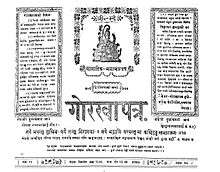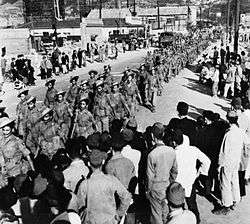Gorkha Kingdom



Gorkhā was a former kingdom in the confederation of 24 states known as Chaubisi rajya located in present-day western Nepal.[1] The Kingdom of Gorkha extended from the Marshyangdi River in the west to the Trishuli River in the east, which separated it from the kingdoms of Lamjung and Nepal respectively.[2] The inhabitants of Gorkha were known as Gorkhali.
Shah dynasty
Shah/Jha/Khan controlled whole area of Ganges and Brahmaputra basin or simply whole land between Himalayas and Vindhyas. Soon the empire divided into several kingdoms. Mughal Empire, Bengal empire and Gorakhpur empire formed after division.[3]
Expansion campaign
From 1736, the Gorkhalis engaged in a campaign of expansion begun by King King Nara Bhupal Shah, which was continued by his son, King Prithvi Narayan Shah and grandson Prince Bahadur Shah. Over the years, they conquered huge tracts of land to the east and west of Gorkha.[4][5]
Among their conquests, the most important and valuable acquisition was the wealthy Newar confederacy of Nepal Mandala centered in the Kathmandu Valley. Starting in 1745, the Gorkhalis mounted a blockade in a bid to starve the population into submission, but the inhabitants held out.
The Newars appealed to the British East India Company for help, and in 1767, it sent an expedition under Captain Kinloch which ended in failure.[6] The three Newar capitals of Kathmandu, Lalitpur and Bhaktapur fell to the Gorkhalis between 1768 to 1769. The Gorkhali king subsequently moved his capital to Kathmandu.[7]
In 1788, the Gorkhalis turned their attention north and invaded Tibet.[8] They seized the border towns of Kyirong and Kuti, and forced the Tibetans to pay an annual tribute. When the Tibetans stopped paying it, the Gorkhalis invaded Tibet again in 1791 and plundered the Tashilhunpo Monastery in Shigatse. This time the Chinese army came to Tibet's defence and advanced close to Kathmandu. The alarmed Gorkhalis appealed to the British East India Company for help, but they got none.[9] Eventually, the Gorkhalis were forced to sign a peace treaty under which they had to pay tribute to Beijing every five years.[10][11]
The Gorkha dominion reached its height at the beginning of the 19th century, extending all along the Himalayan foothills from Kumaon and Garhwal in the west to Sikkim in the east. They were made to return much of the occupied territories after their defeat in the Anglo-Nepalese War (1814–1816).[12][13]
Gorkha to Nepal
The Gorkha dominion continued to be known as Gorkha Rajya (meaning Gorkha Kingdom) until the beginning of the 20th century. Since the 1930s, the name Nepal was used to refer to the entire country as the capital was located in Kathmandu.[14][15] The name Gorkha Sarkar (meaning Gorkha government) was also changed to Nepal government.
Similarly, the Gorkhali language was renamed as Nepali in 1933.[16] The term Gorkhali in the former national anthem entitled "Shreeman Gambhir" was changed to Nepali in 1951.[17] The government newspaper, launched in 1901, is still known as Gorkhapatra (meaning Gorkha gazette).
The Shah dynasty ruled Nepal until 2008 when it became a republic following a people's movement.[18] Today, Gorkha District, roughly corresponding to the old kingdom, is one of the 75 administrative districts of Nepal.
The community name is actually "Gorkha/ Gorkhali" (whether in india or outside) as it was earlier also called even in Nepal, & their language was earlier also officially called Gorkhali both in India & Nepal. Presently called Nepal country, but it was earlier called Gorkha kingdom (Gorkhasthan), inside which there were small chieftainships like Khambuan, Limbuan, Nepal (that time Nepal was the Kathmandu valley only, not outside), Kumaon, Garhwal, Dharmsala, Sikkim, Darjeeling, Terai, etc. ....Even during the life & time of great Gorkha poet Adi Kavi Bhanu Bhakta, the country was still called Gorkha kingdom with official language called as Gorkhali, & hence he had written all his works in Gorkhali (Khas kura), which was already the common language of that entire Gorkha kingdom (which included present Nepal, Kumaon, Garhwal, Dharmsala, Sikkim, Darjeeling, Terai, etc.). But due to political reasons in erstwhile Gorkha kingdom due to which the capital was shifted from Gorkha to Kathmandu (Nepal), the whole Gorkha kingdom/ country's name was also later renamed as Nepal...Due to the same, the Gorkhali language was later renamed as Nepali in Nepal only in 1933.
Gurkhas and Gorkhas

Not to be confused with the inhabitants of the old Gorkha Kingdom only, the Gurkhas are also military units in the British or the Indian army (where they are known as Gorkhas) enlisted in Nepal and India. Their history goes back to the Anglo-Gorkha War and the Sugauli Treaty of 1816. It allowed the British East India Company to recruit men from the Gorkha kingdom hills to serve as soldiers under contract.
The British referred to all those who enlisted as Gurkhas regardless of their ethnic heritage or geographical origin in Gorkha kingdom. These Gurkhas became part of the British Indian Army after its formation.
During World War I (1914–18), more than 200,000 Gurkhas served in the British Army, suffering approximately 20,000 casualties, and receiving almost 2,000 gallantry awards.
During World War II (1939–45), a total of 250,280 Gurkhas served in 40 battalions, plus eight Nepalese Army battalions, plus parachute, training, garrison, and porter units. They earned 2,734 bravery awards, and suffered around 32,000 casualties in all theatres.[19]
Following Indian independence in 1947, the Gurkha regiments were split between Britain and India.
See also
References
- ↑ Hamilton, Francis Buchanan (1819). An Account of the Kingdom Of Nepal and of the Territories Annexed to This Dominion by the House of Gorkha. Edinburgh: Longman. Retrieved 12 January 2013. Page 237.
- ↑ Kirkpatrick, Colonel (1811). An Account of the Kingdom of Nepaul. London: William Miller. Retrieved 12 January 2013. Page 123.
- ↑ Messerschmidt, Don (April 2010). "Bringing Aid To Gorkha's Poor". ECS Nepal. Retrieved 11 January 2013.
- ↑ Hamilton, Francis Buchanan (1819). An Account of the Kingdom Of Nepal and of the Territories Annexed to This Dominion by the House of Gorkha. Edinburgh: Longman. Retrieved 6 January 2013. Page 7.
- ↑ Northey, William Brook and Morris, Charles John (1928). The Gurkhas: Nepal-Their Manners, Customs and Country. Asian Educational Services. ISBN 9788120615779. Pages 30-31.
- ↑ Marshall, Julie G. (2005). "Gurkha Conquest of Nepal and the Kinloch and Logan Missions". Britain And Tibet 1765-1947. Routledge. p. 39. ISBN 9780415336475.
- ↑ Hamilton, Francis Buchanan (1819). An Account of the Kingdom Of Nepal and of the Territories Annexed to This Dominion by the House of Gorkha. Edinburgh: Longman. Retrieved 15 January 2013. Page 7.
- ↑ Marshall, Julie G. (2005). "Nepal 1788-1903". Britain And Tibet 1765-1947. Routledge. p. 57. ISBN 9780415336475.
- ↑ Marshall, Julie G. (2005). "Tibetan-Nepalese Wars 1788-1792". Britain And Tibet 1765-1947. Routledge. p. 72. ISBN 9780415336475.
- ↑ Boulnois, L. "Chinese Maps and Prints on the Tibet-Gorkha War of 1788-92" (PDF). Kailash. p. 86. Retrieved 21 January 2013.
- ↑ "The Enclosing of Nepal". U.S. Library of Congress. Retrieved 21 January 2013.
- ↑ Pradhan, Kumar (1991). The Gorkha conquests: the process and consequences of the unification of Nepal, with particular reference to eastern Nepal. Oxford University Press. Retrieved 6 February 2013.
- ↑ Jha, Pranab Kumar (1985). History of Sikkim, 1817-1904: Analysis of British Policy and Activities. O.P.S. Publishers. p. 11. ASIN B001OQE7EY.
- ↑ Planet, Lonely. "History of Nepal - Lonely Planet Travel Information". www.lonelyplanet.com. Retrieved 2016-05-08.
- ↑ Bindloss, Joseph (2010-09-15). Nepal 8. Lonely Planet. ISBN 9781742203614.
- ↑ Lienhard, Siegfried (1992). Songs of Nepal: An Anthology of Nevar Folksongs and Hymns. New Delhi: Motilal Banarsidas. ISBN 81-208-0963-7. Page 3.
- ↑ "The kings song". Himal Southasian. June 2003. Retrieved 3 April 2012.
- ↑ "Nepal's Gorkha kingdom falls". The Times of India. 2 June 2008. Retrieved 11 February 2013.
- ↑ Parker, John (2005). The Gurkhas: The Inside Story of the World's Most Feared Soldiers. Headline Book Publishing. ISBN 978-0-7553-1415-7.
